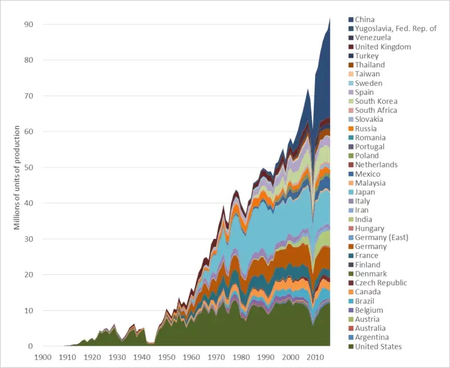
In 1921, refiners started adding tetraethyl lead to gasoline to lubricate cylinder walls and prevent "knocking." For 100 years, lead wafted over the planet, contaminating everything, probably driving many soil-dwelling species to extinction, and sickening, killing and plants, animals and humans worldwide until it was finally outlawed. The last country to ban leaded gasoline did so in 2021. It turned out to be a transitional technology, and other solutions to the knocking program have replaced it, but the lead remains. We'll be paying for the cleanup for generations, and as everyone knows lead is not the only product of combustion from cars.
According to a Huffington Post chronology, "By the end of World War II, it was clear that the oil industry was king, and while...some global oil cabal (may not have controlled events), there is certainly evidence to suggest big oil played a major role in keeping electric cars off the road for...70 or so years. During which time the modern petroleum-fueled economy ravaged prairies and oceans, funded and justified wars, and pumped enough carbon into the atmosphere to assure the crash of the entire climate."
Now the internal combustion engine itself is under assault, as ever more ways it fouls the environment are becoming known. Within the lifetimes of many people now alive, it, too, will be relegated to the ash heap of history as new and better was of moving people and their goods are developed.
Spoiler alert: Lithium-ion batteries are not the only game in town. (One Review
The market for privately owned automobiles could be next. On the horizon are web-based applications that will deliver to your door in minutes, on demand, a perfect, driverless vehicle for the trip you intend to make, with the correct number of seats and cargo space. You will just tell Alexa, Google, Siri... how many passengers and what cargo you need to move and where you want to go, and "Mr. Movement Inc." will do the rest. You'll pay a monthly subscription plus a time-mileage rate for use of the system and the vehicles. Your old sedan, station wagon, minivan, SUV, etc., will not be able to compete.
The system will roll out (couldn't resist) first in major cities and then become ubiquitous. Your great-grandchildren will not yearn for the ol' Model T. Your only problem will be what to do with the 500 square feet of space added to your home by eliminating the garage.
Despite the general replacement, some fueled vehicles (probably burning hydrogen) will remain available for use in certain circumstances, such as in industry, agriculture and remote activities like fighting fires in remote areas.
Fearless prediction: 50% penetration, 15 to 20 years; full deployment, 25 to 30 years. Since I'm almost 80, you may have to tease my descendants if I'm wrong. (And electric airplanes are already flying.)
BTW, electric cars in the US currently amount to about 1% of vehicles on the road. The EV industry is at about the same relative stage of development as the overall auto industrin before the Great Depression (graphic, offset). It is anticipated (Bloomberg) that half of all cars will be electric by 2030. That would suggest roughly a 50-year phase out of most fueled vehicles. The issue is not whether battery-powered cars are "better" but rather: what is the greater problem, and what balance of power will minimize the overall impact of human transportation on the environment?
It may also be pertinent to consider the sources of lithium. As of 2022 the largest proven reserves are in order Chile, Australia and Argentina. Fourth is China. There is as yet no OPEC controlling sources, and the capital to develop the reserves in those relatively small economies must probably come from North America and Europe. Technology will surely seek to create future storage systems from more ubiquitous materials. Thus the predictable transitions should be economically viable.
Original meme


